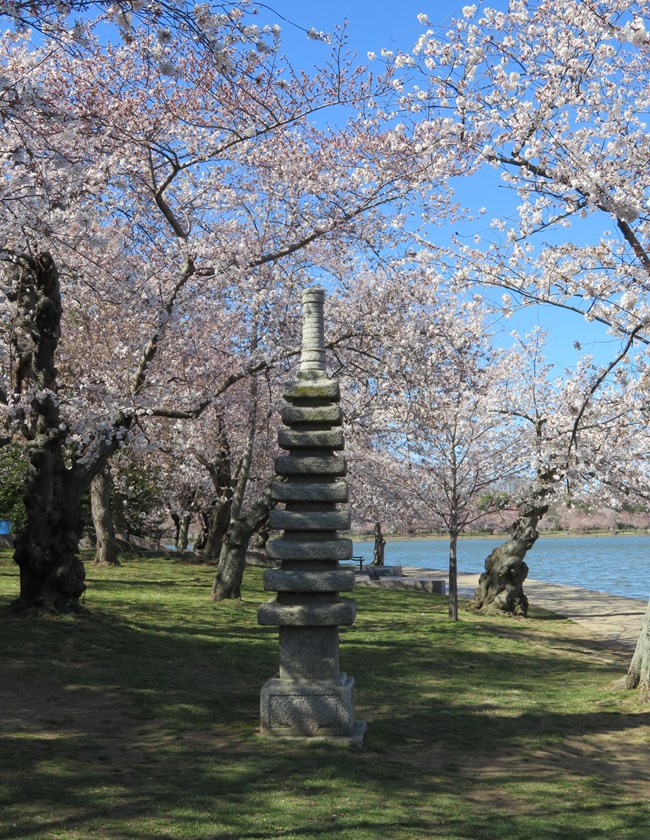Last updated: March 14, 2018
Article
Some Assembly Required, or The Oldest Puzzle in the Park

NPS photo by John Donoghue
In 1958, a gift of friendship was delivered in five shipping crates. It appeared to be a complex stone puzzle, because it came without assembly instructions. With help from the Library of Congress, eventually a Japanese pagoda emerged from the pieces. The National Mall and Memorial Park’s oldest puzzle was solved and completed at its final resting spot-- among the cherry trees on the Tidal Basin.
Dating back to the 17th century, the Japanese pagoda weighs about the same as an automobile, approximately 3,800 pounds. The pagoda is made of nine graduated, square slabs of granite stacked one on top of another. At the top is a ribbed cylinder shape. At the bottom is a square, each side of which is adorned with the image of a Buddha seated on a lotus flower. The sculpture rests on a low square base on a concrete slab. It symbolizes not only friendship, but also a traditional Japanese ideology. From top to bottom there is a symbolic representation of the sky, wind, fire, water and earth. Sky pertains to the big clouds, wind refers to the speed and velocity, fire pertains to the strength, water refers to the river, and earth pertains to the living and non living ecological connections.
The pagoda originated in India as stupas, egg shaped burial mounds with a pole extending from the ground through the top. The shape and structure and sometimes decoration of the mounds represented birth, creation, with the central pole to gather energy from the universe. They were often used as a place of safekeeping for relics. The architectural structure has evolved over time throughout different countries-- shapes, and sizes have changed. In Japan, only the central pole was retained, and stylized into the tiered pagodas we see today. Despite the changed form, the pagodas retain their spiritual significance and appear atop mountains and along ancient roads. They are a symbol of reverence for ancestors and natural elements.
The multi piece sculpture was a gift to the city of Washington, DC by the Mayor Ryozo Hiranuma of Yokohama, Japan in 1957. Former District of Columbia Commissioner Renah Camalier arranged for its placement here among the flowering cherry trees Japan donated in 1912. It is adjacent to the Tidal Basin near the fourth room of the Franklin Delano Roosevelt Memorial.On April 18, 1958, the pagoda was dedicated in continuing recognition of the centennial of the peaceful relations established between the United States and Japan at Yokohama on March 31, 1854 as a special gift from Japan to the United States. This landmark event also is honored by a Washington Monument commemorative stone, a United States Navy Memorial bronze base-relief, and the Japanese lantern across the Tidal Basin.
Take a moment to imagine this pagoda as a symbol of a Japanese garden, traditionally emphasizing balance among the elements of water, stone, and vegetation.
